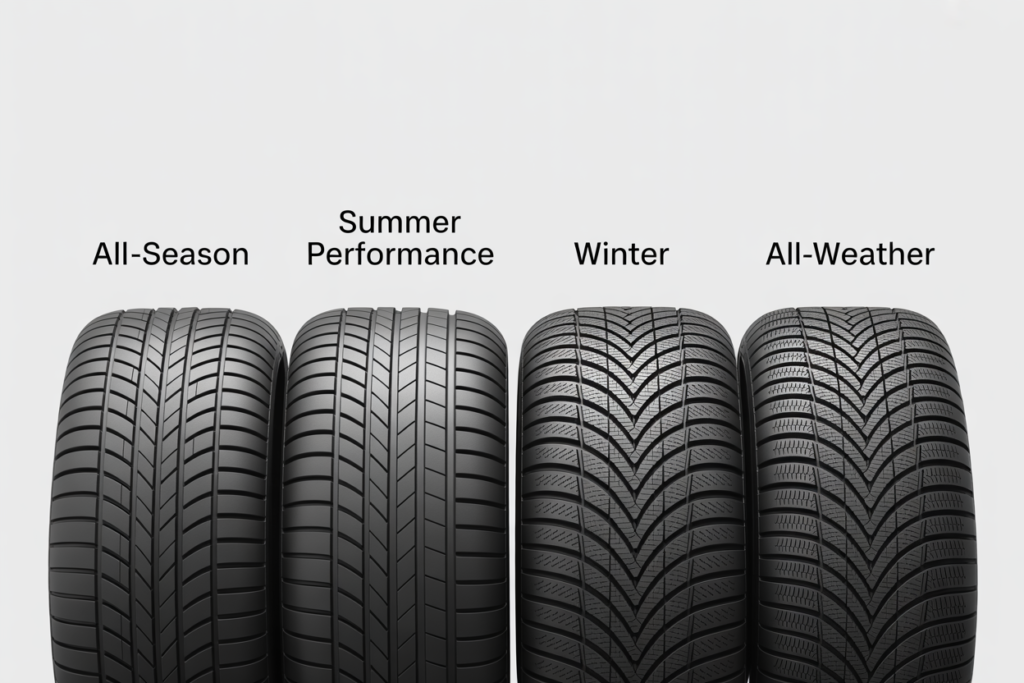Walking into a tire store for the first time feels like entering a foreign country where everyone speaks in mysterious codes. Salespeople throw around terms like “UTQG ratings,” “ply construction,” and “aspect ratios” while pointing at walls lined with seemingly identical black rubber circles—each with wildly different prices.
If you’ve never bought tires before, this experience can be overwhelming. Unlike choosing a phone case or even a laptop, picking the wrong tires has serious consequences. These four rubber rings are literally the only things connecting your two-ton vehicle to the road. Choose poorly, and you risk everything from wasted money to compromised safety.
Here’s what makes tire buying especially tricky for newcomers: unlike most car maintenance, you can’t gradually learn about tires through frequent purchases. The average driver buys new tires just once every four years. By the time you need them again, you’ve forgotten everything from your last purchase—if you were even the one who bought them.

But here’s the good news: tire buying doesn’t have to be intimidating. Despite what commissioned salespeople might imply, you don’t need an engineering degree to make a smart tire purchase. You just need to understand a few key concepts, ask the right questions, and know which sales tactics to avoid.
This guide will transform you from confused first-timer to confident buyer in about ten minutes. You’ll learn to decode tire specifications, understand what you actually need versus what’s just profitable upselling, and navigate the buying process without getting taken advantage of. By the end, you’ll walk into that tire store armed with exactly the knowledge you need—nothing more, nothing less.
Decoding Tire Sizes and Specifications
That cryptic code on your tire sidewall—P215/65R15 94H—might look like a secret language, but it’s actually your roadmap to buying the right replacement. Let’s crack this code together, one element at a time.
Reading Your Tire Size
Find the sizing on your current tire’s sidewall. Here’s what each part means:
P215/65R15
- P: Passenger vehicle tire (might also see LT for light truck)
- 215: Width in millimeters from sidewall to sidewall
- 65: Aspect ratio—the sidewall height is 65% of the width
- R: Radial construction (standard for modern tires)
- 15: Wheel diameter in inches
This exact sequence must match when buying new tires. A 215/60R15 won’t properly fit where a 215/65R15 belongs—that seemingly small difference changes the tire’s overall diameter, affecting speedometer accuracy and potentially rubbing against wheel wells.
Load Index: Your Weight Limit
After the size comes a number like “94”—your tire’s load index. This translates to maximum weight capacity:
- 89 = 1,279 lbs per tire
- 94 = 1,477 lbs per tire
- 99 = 1,709 lbs per tire
Never go lower than your original equipment. If your car came with 94-rated tires, buying 89-rated tires to save money compromises safety and voids warranties.
Speed Ratings: Not Just for Racing
That final letter indicates the tire’s maximum safe speed:
- S = 112 mph
- T = 118 mph
- H = 130 mph
- V = 149 mph
“But I never drive that fast!” True, but speed ratings also indicate the tire’s overall performance capabilities—heat resistance, handling precision, and construction quality. Dropping from H to T ratings might save $20 per tire but degrades emergency handling and highway stability.
Using Your Current Tire as Reference
Before shopping, photograph your tire’s sidewall information. Better yet, check all four tires—previous owners might have mixed sizes. Your driver’s door jamb sticker shows the original specification if you’re unsure what belongs on your vehicle. This five-minute preparation prevents expensive mistakes and pushy salespeople from selling you the wrong size.
Types of Tires Explained
Choosing between tire types is like picking the right shoes—you wouldn’t wear flip-flops to hike or boots to the beach. Understanding these categories helps you buy what you actually need, not what generates the highest commission.

All-Season: The Default Choice
All-season tires are the sensible sneakers of the tire world—good enough for most situations, excellent at none. They’re designed to handle dry roads, rain, and light snow with reasonable competence.
Perfect for:
- Mild to moderate climates
- Drivers who rarely see snow
- Anyone wanting one set year-round
- Budget-conscious buyers
Limitations: Despite the name, all-seasons struggle in real winter conditions. Below 45°F, their rubber hardens, reducing grip even on dry pavement. Think of them as three-season tires with emergency winter capability.
Summer/Performance: When They Make Sense
Summer tires are the sports cars of rubber—incredible in the right conditions, useless in the wrong ones. Their soft, sticky compounds grip like glue in warm weather but turn rock-hard in cold.
Worth considering if:
- You never drive in snow
- Performance handling matters to you
- You live where winters stay above 45°F
- You own a sports car or performance sedan
Reality check: Unless you’re an enthusiast or live in a truly warm climate, summer tires create more hassle than benefit.
Winter: Beyond Just Snow
Winter tires aren’t just for blizzards. Once temperatures consistently drop below 45°F, they outperform all-seasons on any surface—wet, dry, or snowy. Their magic lies in rubber compounds that stay flexible when others turn brittle.
Essential for:
- Regular snow or ice driving
- Mountainous regions
- Anywhere with real winters
- Safety-conscious drivers in cold climates
The catch: You need storage space and must swap them seasonally. Budget for either mounting costs or a second set of wheels.
All-Weather: The New Compromise
All-weather tires (different from all-season) carry the severe weather snowflake symbol, meaning they meet winter tire standards while being usable year-round. They’re the Swiss Army knife attempting to eliminate seasonal swaps.
Best for:
- Moderate winter areas
- Drivers wanting winter capability without the hassle
- Those lacking storage space
- Unpredictable weather regions
Trade-off: Jack of all trades, master of none. They wear faster than all-seasons in summer and can’t match dedicated winter tires in severe conditions. Still, they’re an intelligent compromise for many drivers.
Setting Your Budget
Tire prices swing wildly—from $50 bargain specials to $300 premium models. Understanding what drives these prices helps you find the sweet spot between safety and savings.

Price Ranges: Budget vs Premium
Budget Tires ($50-80 each)
- Often unknown brands or private labels
- Basic compounds and construction
- Shorter lifespan (25,000-40,000 miles)
- Adequate for light, local driving
Mid-Range ($80-150 each)
- Established second-tier brands
- Good balance of performance and value
- Typical lifespan (45,000-60,000 miles)
- Sweet spot for most drivers
Premium ($150-300+ each)
- Major brands’ top models
- Advanced compounds and technology
- Longest lifespan (60,000-80,000 miles)
- Best performance and comfort
Hidden Costs Nobody Mentions
That advertised price is just the beginning. Real cost includes:
- Mounting and balancing: $15-45 per tire
- Valve stems: $2-5 each (should always be replaced)
- Disposal fees: $2-5 per old tire
- TPMS service: $5-10 per wheel
- Road hazard warranty: $10-20 per tire
- Alignment check: $20-100 (often necessary)
- Taxes: 6-10% on everything
A “$75 tire” easily becomes $120 out the door. Always ask for the “out-the-door” price including everything.

Why the Cheapest Option Costs More
Budget tire math rarely works:
- Wears out in 30,000 miles instead of 60,000
- Poor wet traction increases accident risk
- Higher rolling resistance wastes fuel
- Requires replacement twice as often
That $200 saved buying cheap tires? You’ll spend it on earlier replacement, extra fuel, and potentially one insurance deductible.
Finding Your Sweet Spot
For most drivers, the value zone sits between $100-130 per tire before installation. This range gets you:
- Reputable brand quality
- 50,000+ mile warranties
- Good all-weather performance
- Peace of mind safety
Skip the bottom tier unless you’re selling the car soon. Avoid premium tires unless you drive aggressively, value performance, or keep cars long-term. The middle ground offers 90% of premium performance at 70% of the cost.
Where to Buy
Choosing where to buy tires impacts price, service quality, and your overall experience. Each option has distinct advantages and potential pitfalls.
Tire Chains vs Independent Shops
National Chains (Discount Tire, NTB, Firestone) Pros:
- Nationwide warranties and free rotations
- Standardized pricing and services
- Multiple locations for convenience
- Often run promotions and rebates
Cons:
- Higher pressure sales environment
- Push additional services aggressively
- Less personalized service
- Quality varies by location
Independent Shops Pros:
- Often better prices on installation
- More willing to negotiate
- Personal relationships and trust
- Support local business
Cons:
- Warranty work only at that location
- Quality varies dramatically
- May have limited tire selection
- Less convenient hours
Online Retailers
Sites like TireRack and SimpleTire have revolutionized tire buying:
Advantages:
- Extensive selection and reviews
- Often 20-30% cheaper than stores
- No sales pressure
- Detailed comparison tools
The Process:
- Order tires shipped to installer
- Schedule installation appointment
- Pay only for mounting service
Hidden benefit: Shops can’t upsell you on tires you already own. Installation-only pricing is often cheaper than their package deals.
Dealerships
Dealer service departments offer:
- OEM-spec tires guaranteed to fit
- Integrated with other services
- Factory-trained technicians
- Warranty peace of mind
Reality check: Dealerships typically charge 30-50% more than other options. That convenience costs $200-400 extra per set. Unless under warranty or leasing, shop elsewhere.
Warehouse Clubs
Costco and Sam’s Club surprise many first-time buyers:
The Good:
- Excellent tire prices
- Installation included in many deals
- Road hazard warranties included
- No high-pressure sales
The Catch:
- Limited brand selection
- Appointment availability issues
- Membership required ($60-120 annually)
- May not have your size in stock
Best for: Members who plan ahead and find their size available. The savings often justify membership cost for tire purchases alone.


